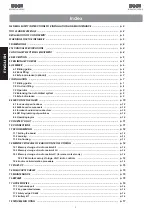
5
8
Before definitely fixing the front fixing plate to the gate, carry out some performance tests, the ball bearing joint still fully screwed in.
Let the shaft come out to its full extension so to check if the above plate is in the correct position and fix it by welding. See picture 5.
Where brick piers are involved and the gates prehung or the gate hinges are mounted in the middle of the pier, there may be brickwork
to cut out in order to allow clearance for the operator between the pier and the open gate. The fixing distances are always to be referred
to the centre of the hinge and rear lock nut and bolt. Picture 14-15.
And now the electrical work. Keep to the diagram as shown in picture 18.
N.W: CARRY OUT A RISK ANALYSIS IN COMPLIANCE WITH EN 12445 AND EN 12453 NORMS AND FIT ANY SAFETY DEVICE WHERE
REQUIRED.
General layout of the system complete with all the recommended accessories. Picture 16.
In events like power failure, HINDI 880 two- or one-way locking is designed to be released so that the gates can be pushed open by
hand. Picture No. 4 shows how to do it. Lift the flap cover that protects the lock and open the top lid. Inside you will find the special
release key part No. 1625. Turn it anti-clockwise by one complete turn. Should the gates be so wide that an electric lock is required
for a better hold, after releasing the operator, remember to release the electric lock as well by its proper key, and then push the gates
open. See picture 11-12.
PIC. 4
PIC. 5
PIC. 6
MANUAL RELEASE
ANTI-CLOCKWISE.
ONE COMPLETE TURN
RELEASE
TIGHTEN
TO LOCK
1625
3
rd
OPERATION
1
st
OPERATION
2
nd
OPERATION
DETAIL OF THE VALVE ENCLOSURE.
ALL THE VALVES ARE IN ONE BODY
SPECIAL KEY
FOR VALVE ENCLOSURE
VALVE ENCLOSURE
BALL BEARING JOINT
PROTECT THE SHAFT DURING WELDING
REINFORCEMENT PLATE
CENTRE OF GATE HINGE
GATE LEAF
130
200
70
130
INDENTED GATE POST HORIZONTAL
SECTION VIEW
CUT OUT BRICK PIER TO HAVE
CLEARANCE FOR THE OPERATOR
GATE LEAF
130
200
70
130
1˙210
PIC. 15
PIC. 14
PIC. 17
JUNCTION BOX
I M P O R TA N T: N O S H A R P B E N D .
SMOOTH LONG LOOP IS RECOMMENDED
PIC. 16
After fixing the plate to the gate, it is important to unscrew the ball bearing joint by 5 or 6 mm, then re-tighten the nut. A sort of oil cushion
is created in this way between the operator end casting “
T
”and the piston “
S
”. Pic. 6. This will prevent the ram from reaching the very
limit of the permitted stroke and the gates are firmly held in closed gate position, as shown in pic. 10 on page 7.
5 or 6 mm
REINFORCEMENT PLATE
6
“S”
“T”
1
2
3
4
5
6
7
8
9
10
11
12
13
8
14
2x1
2x1
2x1
2x1
4x1
4x1
4x1,5
3x1,5
4x1,5
4x1
cable
RG58
4x1
1 - Flashing lamp MIRI 4
2 - Photocell receiver POLO 44
3 - Push button PULIN 3
4 - Control box ELPRO 13 CEI
5 - Plug-in radio receiver ASTRO 43
6 - 230V 50/60Hz differential, magnetic
thermal mains switch type 0.03A
(beyond 100m use cables with 2.5mm Ø)
7 - Post with photocell projector POLO 44
8 - Electro-hydraulic operator HINDI 880
9 - Electric lock
10 - Post with photocell receiver POLO 44
11 - Photocell transmitter POLO 44
12 - Keyswitch PRIT 19
13 - Aerial BIRIO A8
14 - Radio transmitter ASTRO 43/2 Small
IMPORTANT
: All the electrical equipment to be properly earthed






























